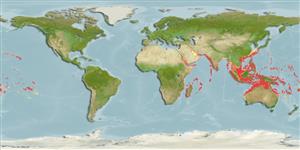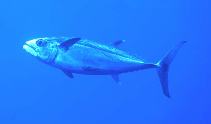Gymnosarda unicolor (Rüppell, 1836)
Dogtooth tuna
添加你自己的观测位置在 Fish Watcher
| Native range | All suitable habitat | Point map | Year 2050 |

|
| This map was computer-generated and has not yet been reviewed. |
| Gymnosarda unicolor AquaMaps Data sources: GBIF OBIS |
Maldives country information
Common names:
Dogtooth tuna, Thon à gros yeux, Worhimas
Occurrence: native
Salinity: marine
Abundance: | Ref:
Importance: | Ref:
Aquaculture: | Ref:
Regulations: | Ref:
Uses: no uses
Comments: Also Ref. 168, 5579.
National Checklist:
Country Information: https://www.cia.gov/library/publications/resources/the-world-factbook/geos/mv.html
National Fisheries Authority:
Occurrences: Occurrences Point map
Main Ref: Randall, J.E. and C. Anderson, 1993
National Database:
Occurrence: native
Salinity: marine
Abundance: | Ref:
Importance: | Ref:
Aquaculture: | Ref:
Regulations: | Ref:
Uses: no uses
Comments: Also Ref. 168, 5579.
National Checklist:
Country Information: https://www.cia.gov/library/publications/resources/the-world-factbook/geos/mv.html
National Fisheries Authority:
Occurrences: Occurrences Point map
Main Ref: Randall, J.E. and C. Anderson, 1993
National Database:
Common names from other countries
分类 / Names 俗名 | 同种异名 | Catalog of Fishes(属, 种) | ITIS | CoL | WoRMS | Cloffa
Teleostei > Scombriformes (Mackerels) > Scombridae (Mackerels, tunas, bonitos) > Scombrinae
Etymology: Gymnosarda: Greek, gymnos = naked + Greek, sarde = sardine; 1598 (Ref. 45335).
More on author: Rüppell.
Etymology: Gymnosarda: Greek, gymnos = naked + Greek, sarde = sardine; 1598 (Ref. 45335).
More on author: Rüppell.
Environment: milieu / climate zone / depth range / distribution range 生态学
海洋 礁区鱼类; 海洋洄游的 (Ref. 51243); 深度上下限 0 - 250 m (Ref. 86942). 熱帶; 20°C - 28°C (Ref. 5313); 31°N - 30°S, 32°E - 130°W (Ref. 168)
分布 国家 | FAO区域 | 生态系 | 标本纪录 | Point map | 简介 | Faunafri
Indo-Pacific: Red Sea and East Africa to French Polynesia, north to Japan, south to Australia.
印度-太平洋: 紅海而且東非到法屬玻里尼西亞,北至日本, 南至澳洲。
印度-太平洋: 紅海而且東非到法屬玻里尼西亞,北至日本, 南至澳洲。
大小 / 重量 / 年龄
Maturity: Lm ? range ? - ? cm
Max length : 248 cm FL 雄鱼/尚未辨别雌雄; (Ref. 40637); common length : 190 cm NG 雄鱼/尚未辨别雌雄; (Ref. 9710); 最大体重: 131.0 kg (Ref. 168)
Max length : 248 cm FL 雄鱼/尚未辨别雌雄; (Ref. 40637); common length : 190 cm NG 雄鱼/尚未辨别雌雄; (Ref. 9710); 最大体重: 131.0 kg (Ref. 168)
简单描述 检索表 | 型态特徵 | 形态测量图
背棘 (总数) : 13 - 15; 背的软条 (总数) : 12 - 14; 臀棘: 0; 臀鳍软条: 12 - 13; 脊椎骨: 38. This species is distinguished by the following characters: body elongate and moderately compressed; mouth fairly large, upper jaw reaching to middle of eye; 14 to 31 large, conical teeth on upper jaw, 10 to 24 on lower jaw; 2 patches of villiform teeth on upper surface of tongue; total gill rakers on first gill arch 11-14; D1 XIII-XV, its border almost straight, the second followed by 6-7 finlets, dorsal fins close together; anal fin followed by 6 finlets; pectoral fins with 25-28 rays; interpelvic process large and single; lateral line strongly undulating; body naked posterior to corselet except for lateral line, dorsal-fin base, and caudal keel; caudal peduncle slender, with a well-developed lateral keel between 2 smaller keels on each side. Colour of back and upper sides brilliant blue-black, lower sides and belly silvery; no lines, spots or other markings on body; anterior tip of first dorsal fin dark; other fins greyish (Ref. 9684).
嘴非常大的, 上颌延伸到眼的中央。 嗅觉毛簇的叶片 48 到 56. 腹鳍间的突起大的与单个。 侧线强烈波浪形的。 身体裸露的在甲胄后面。 泳鳔大的, 脾脏看得见的由腹面观之在身体的右边上。 背部与上侧面色彩艳丽的蓝黑色的, 下侧与腹面银色的; 没有在身体上的线, 斑点或其他的斑纹。
嘴非常大的, 上颌延伸到眼的中央。 嗅觉毛簇的叶片 48 到 56. 腹鳍间的突起大的与单个。 侧线强烈波浪形的。 身体裸露的在甲胄后面。 泳鳔大的, 脾脏看得见的由腹面观之在身体的右边上。 背部与上侧面色彩艳丽的蓝黑色的, 下侧与腹面银色的; 没有在身体上的线, 斑点或其他的斑纹。
An offshore species found mainly around coral reefs. Generally solitary or occur in small schools of six or less. Preys on small schooling fishes such as Decapterus, Caesio, Nasio, Cirrhilabrus, Pterocaesio and squids. Caught mainly by pole-and-line. Marketed canned and frozen (Ref. 9684, 48637). Adults may be ciguatoxic (Ref. 37816). Minimum depth reported taken from Ref. 128797.
一个外海种主要地珊瑚礁的周围发现。 通常独居性的或六以内形成小群鱼群。 捕食小的群游性鱼例如 Decapterus , Caesio , Nasio , Cirrhilabrus , Pterocaesio 与乌贼。 在市场上销售罐装及冷冻.(参考文献 9684,48637) 成鱼可能具有热带海鱼毒.(参考文献 37816)
一个外海种主要地珊瑚礁的周围发现。 通常独居性的或六以内形成小群鱼群。 捕食小的群游性鱼例如 Decapterus , Caesio , Nasio , Cirrhilabrus , Pterocaesio 与乌贼。 在市场上销售罐装及冷冻.(参考文献 9684,48637) 成鱼可能具有热带海鱼毒.(参考文献 37816)
Life cycle and mating behavior 成熟度 | 繁殖 | 产卵场 | 卵 | 孕卵数 | 仔鱼
印度-太平洋: 紅海而且東非到法屬玻里尼西亞,北至日本, 南至澳洲。
主要参考文献
Upload your references | 参考文献 | 合作者 : Collette, Bruce B. | 合作者
Collette, B.B. and C.E. Nauen, 1983. FAO Species Catalogue. Vol. 2. Scombrids of the world. An annotated and illustrated catalogue of tunas, mackerels, bonitos and related species known to date. Rome: FAO. FAO Fish. Synop. 125(2):137 p. (Ref. 168)
人类利用
渔业: 低经济; 游钓鱼种: 是的
FAO(渔业: 产生; publication : search) | FishSource | 周边海洋
更多信息
Population dynamics
成长参数
Max. ages / sizes
Length-weight rel.
Length-length rel.
体长-频率
Mass conversion
入添量
丰度
成长参数
Max. ages / sizes
Length-weight rel.
Length-length rel.
体长-频率
Mass conversion
入添量
丰度
Physiology
Body composition
Nutrients
耗氧量
游泳类型
游泳速度
Visual pigments
Fish sound
Diseases & Parasites
Toxicity (LC50s)
Body composition
Nutrients
耗氧量
游泳类型
游泳速度
Visual pigments
Fish sound
Diseases & Parasites
Toxicity (LC50s)
Genetics
遗传学
Heterozygosity
遗传率
遗传学
Heterozygosity
遗传率
工具
Bio-Quiz | E-book | 野外调查 | 检索表 | 长度- 频率 Wizard | 生活- 历史的工具 | 分布图 | Classification Tree
| Catch-MSY |
特别资料
下载 XML
网络资源
Aquatic Commons | BHL | Cloffa | Websites from users | 核实 FishWatcher | CISTI | Catalog of Fishes(属, 种) | DiscoverLife | ECOTOX | Faunafri | Fishtrace | GenBank(基因组, 核苷酸) | GloBI | GOBASE | | Google Books | Google Scholar | Google | IGFA World Record | MitoFish | 国家资料库 | Otolith Atlas of Taiwan Fishes | PubMed | Reef Life Survey | Scirus | SeaLifeBase | 树状分类阶层 | Wikipedia(转至, 搜寻) | World Records Freshwater Fishing | 动物学的记录
Estimates based on models
Preferred temperature (Ref. 115969): 20.9 - 28.2, mean 26.5 (based on 938 cells).
Phylogenetic diversity index (Ref. 82804): PD50 = 1.0000 [Uniqueness, from 0.5 = low to 2.0 = high].
Bayesian length-weight: a=0.01096 (0.00661 - 0.01818), b=3.06 (2.92 - 3.20), in cm Total Length, based on LWR estimates for this species & (Sub)family-body (Ref. 93245).
营养阶层 (Ref. 69278): 4.5 ±0.75 se; based on food items.
回复力 (Ref. 120179): 低的, 最小族群倍增时间4.5 - 14 年 (Assuming tmax>10).
Fishing Vulnerability (Ref. 59153): Very high vulnerability (90 of 100).
Climate Vulnerability (Ref. 125649): Very high vulnerability (92 of 100).




